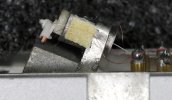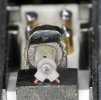Putting the question in this thread instead. Those of you that have Nagaokas MP-500 with a boron solid cantilever: Is it possible to get some measurements of the boron cantilever length? Just that portion that is visible as the boron rod. The JICO boron rod is just below 4 mm long, I would guess 3.8 mm. Obray specifies their boron cantilevers as 6±0.2 mm.
View attachment 408601
View attachment 408601


